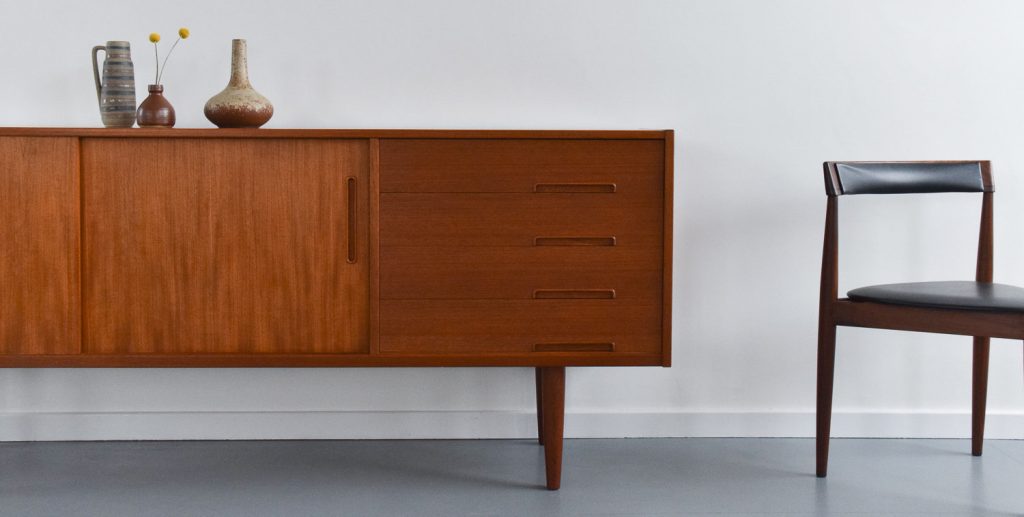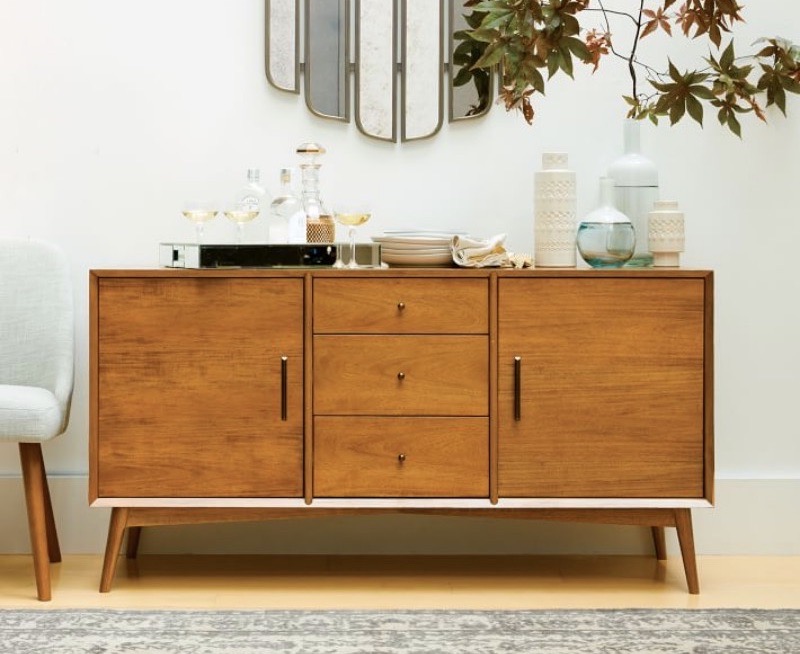Why Every Home Needs A Vintage Sideboard
Sideboards are among Design Addict’s most sought after vintage designs. Other popular forms of storage – cabinets, dressers, chests of drawers – are quickly being eclipsed by this sleek cousin. For those unfamiliar with the term, what is a sideboard? Popularised by mid century design, the sideboard is an oblong, relatively low storage unit which, more often than not, stands on elegant tapered feet. Not to be confused with console tables, which provide the same surface space but do not come with the handy bonus of extra storage!

HOW TO ASSESS THE QUALITY OF A VINTAGE DESIGN
For finding a vintage sideboard on a budget, there are countless options from lesser known brands. British furniture manufacturers Meredrew produced an attractive array of sideboards during the 1960s and 70s. No matter the brand, the key is to look for good quality manufacturing. Modern sideboards use many of the same materials that were used in the mid century period but very often only the components are made in a factory – responsibility for assembly has largely been passed to the customer. Ease of assembly is now the overriding factor in how an item is made, rather than the long-term strength and usability of the piece.
WHAT GOES INTO THE MAKING OF A SIDEBOARD
Unfortunately this creates weak spots in modern designs. For example, where the joints of a mid-century piece might be dowelled and glued with a high strength adhesive and left for hours to dry, a modern piece will use a quarter turn of some screws to make the same joint – easy to assemble, but nowhere near as strong. In similar fashion, mid century furniture typically uses proper recessed hinges on their doors, whereas a modern piece is very likely to use low quality kitchen cabinet style hinges which push into pre-drilled holes. These hinges tend to sag after a while, and the holes they sit in create an area of weakness, leading to doors falling off at the least provocation. Vintage dealers should be able to point out these more subtle indicators of a design which means that the sideboard has been built to last.
THE 1960S PRODUCED THE MOST FAMOUS SIDEBOARD DESIGNS
Popular sideboard models are those arising from the 1960s. The sleek, minimalist contours of the mid century modern aesthetic lend a timeless quality to furniture and it makes a great investment when choosing significant pieces for your home. Sideboards also come in a variety of shapes and sizes, meaning that they provide essential – yet stylish – pockets of storage for even the most compact of spaces. Perfect for city homes as well as more spacious country abodes!
Pinterest has done much to boost the status of vintage sideboards – think gleaming teak models adorned with house plants and a carefully curated array of homeware accessories. A glimpse inside most homes of boho-style lovers will reveal a sideboard paired with a stylish armchair and a weathered antique rug.

The joy of sideboards is that they work beautifully with so many different styles and tastes. From impressive traditional room scapes filled with lofty antiques to a striking, minimalist contemporary home or cosy bohemian digs, there really is a characterful vintage sideboard for every budget, lifestyle and taste.
WHICH SIDEBOARD BRANDS SHOULD BUYERS LOOK OUT FOR?
Danish designer Ib Kofod Larsen has produced many distinctive sideboards which are generally longer in width for both G Plan and Danish brand Faarup, whereas his peer Børge Mogensen is known for creating stockier, more cuboid designs. Celebrated brand Ercol also boasts a distinctive collection of sideboards, which are usually made using luminescent blonde woods like elm, beech and ash.

USE THE SIDEBOARD TO PROP UP ARTWORK
For renters unable to hang framed pictures, a good alternative for elevating artwork is to lean them against the wall atop a sideboard. Choose a piece of statement artwork – such as a giant framed print – or scatter smaller frames together. Lending the space a bohemian, artistic feel, this alternative to hanging imagery will appease any nervous landlords without preventing you from living in a characterful home.

REPURPOSE YOUR SIDEBOARD AS A BATHROOM VANITY UNIT
Another innovative way to use a sideboard is to repurpose it as a vanity unit, providing extra bathroom storage. Vintage finds in the bathroom seem odd? It might not seem like the usual approach to kitting out a new bathroom. Recent times, however, have seen an inspiring rise in people choosing to incorporate vintage chic into their bathrooms. Moving away from costly fitted cabinets, many have travelled down the alternative path of sourcing a vintage storage unit and transforming it into a stunning vanity unit for the sink. This is not only cost-effective, it is also a brilliant way to lend spades of character and individuality to your bathroom. Be gone, generic plastic cabinets and hotel style bathrooms!



